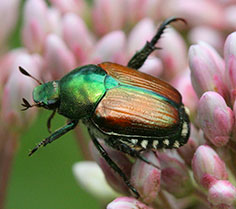Japanese Beetle Pest Profile


Description
The adult beetle is a broadly oval insect about 13 millimeters long (0.5 inch) and about six millimeters wide (0.25 inch). The body is a bright metallic green, the legs are a darker green, and the wing covers are a coppery brown and do not quite extend to the end of the abdomen. There are two small tufts of white hairs just behind the wing covers and five patches along each side. The small white oval eggs are laid in the soil. The larva is C-shaped with three pairs of legs, white, and grows to 25 millimeters in length (one inch). Pupae are light reddish-brown and 13 millimeters long (0.5 inch).
Host and Damage
A wide range of plants are attacked in the U. S. by the adult beetles, which skeletonize leaves by eating around the larger veins and chew on flowers. Hosts include small fruits, tree fruits, truck and garden crops, ornamental shrubs, vines, and trees. Feeding studies show a host range in excess of 300 plants in 79 plant families. Among the preferred plants are grape, apple, cherry, peach, plum, rose, and corn. Corn is injured by eating the silk which interferes with formation of kernels. Soft fruits such as grapes, berries, and stone fruits may be completely consumed. Medium to high densities of larvae will cause patches of dead grass.
Distribution
The Japanese beetle is native to the main island of Japan. The beetle is currently found in coastal and adjacent states from Maine to Alabama with small infestations westward to beyond the Mississippi River.
Life Cycle
Females lay eggs in small clusters of one to four eggs within cells two to four inches below the soil surface. Each female may lay 40 to 60 eggs in her lifetime. Eggs hatch in 10 to 14 days. Larvae feed on many types of plant roots, but are fond of grasses. They move deeper into the soil at the onset of winter, and return to the root zone in the spring to feed. Larvae develop through three instars. Pupation takes place in earthen cells later in the spring, and adults emerge after eight to 20 days. There is usually one generation per year, although larvae can take up to two years to develop in unfavorable conditions such as wet, damp soils. The adults emerge from May to September and feed on foliage, flowers and fruit. The exact timing of emergence depends upon geographical location and weather.
History & Economic Importance
The Japanese beetle is originally from Japan, and was first found in the U.S. in 1916 in New Jersey. It is not a serious pest in Japan where there are relatively few large grassy areas favorable for its reproduction, and the action of predators, parasites, and pathogens keep the beetle numbers low. In the U.S. however, a favorable climate, large areas of permanent turf for reproduction, and ineffectual natural enemies favor increased population densities. It is considered a serious pest of turf, and adults damage a wide variety of both ornamental and agricultural plants.
